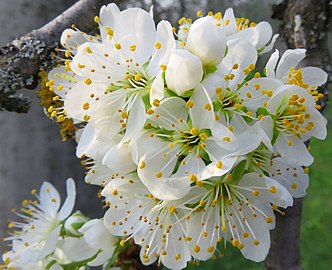European Plum Tree and Fruit: Detailed Overview
European plums (Prunus domestica) are versatile and hardy fruit trees native to Europe and Western Asia. They are valued for their high-quality fruits, which are used fresh, dried (as prunes), or processed into jams, pastries, and beverages.
Tree Characteristics
- Size: Typically grows 4-6 meters tall, depending on the rootstock and pruning. Compact in size compared to many other fruit trees.
- Lifespan: Productive for 15-30 years, with proper care.
- Growth Habit: Upright to spreading canopy, ideal for backyard orchards and small spaces.
- Leaves: Broad, oval, with finely serrated edges, dark green on top and lighter below.
- Wood Suckering: European plums can produce root suckers, especially when grown on their own roots. However, when grafted onto suitable rootstocks (e.g., Myrobalan or Marianna plum), suckering is reduced.
Fruit Characteristics
- Shape and Size: Oblong to oval; size varies depending on variety, ranging from 2-8 cm in length.
- Skin: Smooth and often covered with a natural waxy coating; colours range from purple, blue, green, and yellow to reddish hues.
- Flesh: Firm, sweet, and juicy, with a rich flavour. The flesh can cling to the pit (clingstone) or easily separate (freestone).
- Stone: Oblong and usually smooth.
European vs. Asian Plums
| Aspect | European Plums | Asian Plums (Prunus salicina) |
|---|---|---|
| Shape | Oval or oblong | Round or heart-shaped |
| Skin Texture | Thick and waxy | Thin and smooth |
| Flavour | Sweet and rich | Tart and juicy |
| Harvest Season | Late summer to autumn | Mid to late summer |
| Climate Adaptation | Cooler temperate climates | Warmer climates, tolerates humidity |
| Suckering Tendency | Moderate | Minimal |
Grafting Compatibility
- European plums are compatible with Myrobalan plum (Prunus cerasifera), Marianna rootstock, and sometimes peach or apricot rootstocks.
- Grafting onto dwarfing rootstocks like Pixy can help control tree size, making it ideal for small gardens.
- They are less compatible with Asian plum rootstocks, though hybrids like pluots (plum-apricot crosses) can sometimes bridge compatibility gaps.
Suitability to New Zealand Climate
- Optimal Conditions: European plums thrive in New Zealand's temperate climate, especially regions with cold winters and warm, dry summers.
- Chilling Requirement: Requires 700-1,200 chilling hours (below 7°C) during winter for optimal flowering and fruit set.
- Soil Preference: Performs well in fertile, well-drained soils with a pH of 6.0-6.5.
- Rain Sensitivity: Fruits can crack if heavy rain coincides with ripening; this is less of an issue in drier regions of New Zealand.
Pollination Requirements
- Self-Fertility: Some European plum varieties (e.g., 'Stanley,' 'Blue Tit') are self-fertile and can produce fruit without a pollinator.
- Cross-Pollination: Many varieties (e.g., 'Victoria,' 'Green Gage') require cross-pollination. Use compatible varieties that bloom simultaneously for best results.
- Pollinators: Bees are primary pollinators; companion planting with bee-friendly plants like lavender and borage enhances pollination.
Uses in Forest Gardening
- Interplanting: European plums pair well with nitrogen-fixing plants (e.g., clover, comfrey) and shallow-rooted perennials to build soil health.
- Ecosystem Benefits: Provides shade and habitat for beneficial insects, while the dense canopy can reduce evaporation in nearby plants.
European plums are a rewarding choice for growers in New Zealand, offering diverse uses, adaptability to cooler climates, and compatibility with sustainable gardening practices.




